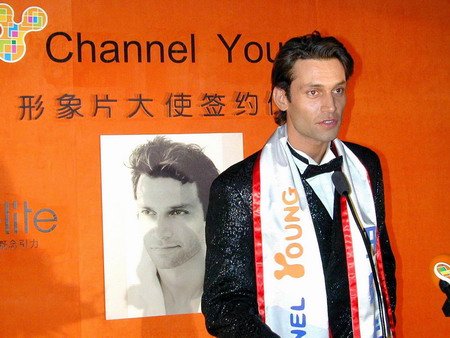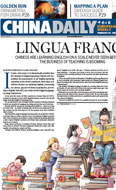Photos
Chanel finds a fashionable home on Channel Young
Updated: 2011-02-28 11:16
By Xu Junqian (China Daily)
|
 |
|
French model Fabrice Wattez speaks to the audience during a broadcast on Channel Young, a Shanghai-based TV station that focuses purely on fashion and urban lifestyles, the only one of its kind in China. [Photo / Dong Hongjing] |
Centered around its biggest ever exhibition in China, Culture Chanel, the program, sharing the same name as the exhibition, was aired at 10:30 pm every night from Jan 14 for a fortnight. It was shown on Channel Young, a Shanghai-based TV station that focuses purely on fashion and urban lifestyles, the only one of its kind in China.
Not only has it been a boost for Chanel but it is also a marketing bonanza for the TV station, with ratings climbing to an historical high of more than four points.
The program featured a documentary-like review of the fascinating life of Gabrielle Coco Chanel, the late founder of the fashion house, and her brilliant designs. It stood out like a shining beacon among the usual fare served up by rival broadcasters with its refreshing and hip touch.
"What we are doing is innovative in the Chinese media industry," said Bao Xiaoqun, general manager of Channel Young.
"Luxury brands in China usually prefer to seek more in-depth media coverage with international magazines such as ELLE, which are believed to have a more upmarket readership, whereas television is tailored to all viewers. But we are proving we can make programs as elegant, effective and value-for-money as the magazines, if not more so."
No detailed business numbers were provided from either side of the program, but it turned out to be a worthwhile exercise because the TV station has won a long list of high-class clients, including Ferragamo, Mont Blanc and Hermes.
Launched in 2003 by its parent company, Shanghai Media Group, China's second-largest media conglomerate by revenue after China Central Television, Channel Young started as an obscure information platform, introducing popular dining and shopping venues in the bustling city.
With its clear focus on the young and hip upcoming middle classes, with their high purchasing power, and a far-sighted strategy, it gradually became one of the most popular channels in the city, and also one of the most profitable subsidiaries of the group's 11 channels. It grossed 500 million yuan ($75.8 million) in 2010, with advertising income accounting for 90 percent of the commercial sales turnover.
It is expected that the revenue will enjoy another 20 percent jump this year, reaching 600 million yuan, while the proportion of advertising income will drop to 80 percent, an intentional effort to "decommercialize the channel".
"With the progress we have achieved, what we are pursuing now should no longer be the simple business numbers. We want to influence the way the Chinese live, which happens to be the philosophy of our channel," said Bao.
The influence of the channel is already far-reaching. Every boutique store, restaurant or garment that it recommended attracts huge custom the next day, with customers lining up to buy into the fashion.
| ||||
Bao said: "We want to tell our audiences the reason why Gabrielle Chanel, a girl abandoned by her father who grew up in an orphanage, became Coco Chanel, a household name not only in the fashion industry but also around world. It is not because of the many zeros on her price tag, but the avant-garde spirit she pioneered," said Bao, who spent several years in France on a doctoral degree.
"In the meantime, we are looking for similarly talented designers in China to bring them into the public eye through our channel."
In 2008, the same year that the TV station started its cooperation with international premium brands, the first season of a weekly reality TV series focusing on fashion design called Magic Scissors was produced and broadcast by the channel.
The show, which lasted 60 minutes an episode and aired every Sunday night for 13 weeks, gathered 20 contestants - mostly fashion school graduates - from all over China every year subsequently. The contestants, usually restricted in theme, time and materials, compete with each other to create the best clothes, and are judged with one or more eliminated every week. The winner gets the chance to study design at a Paris fashion institute for one year, and a contract with a local fashion house.
The show is a copy of the formidable ratings draw Project Runway, shown on TV in the United States. But as the first and only professional fashion design contest in China, it has helped many entrants, not just the champion, win more acclaim and find a better job, such as creative director, with local brands.
The channel also set up an annual Gold Thimble award, inspired by the French award of the same title, to honor the most distinguished Chinese designer of the year. The prize is a real gold thimble with a diamond border worth 200,000 yuan.
In spite of his dazzling achievements so far, Bao still feels the future will be tough and unpredictable because "the fashion industry in China has yet to be built, let alone to blossom".
"It's like we are the only fighters. Chinese consumers are still focusing on the sales promotions of Louis Vuitton or other big names, while individual designers are still too powerless and Chinese-born garment manufacturing giants understand little about the essence of the culture behind these big names," said Bao.
E-paper

Chinese tourists as top shoppers
Since last summer, Chinese tourists emerged as the top tax-free shoppers in Europe.
Golden run ahead
Looking abroad
Mapping out a plan
Specials

The green lantern
Environmental concerns are shedding new light on a colorful tradition

Inland interchange
Chongqing bets on its position as a hub for China's west.

Zooming in on Chinese skies
Helicopter companies ride on country's growing interest in luxury aviation.




